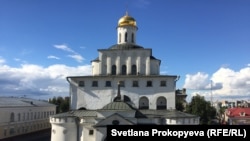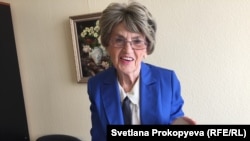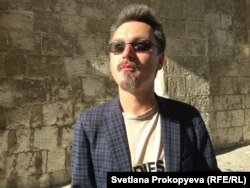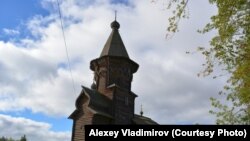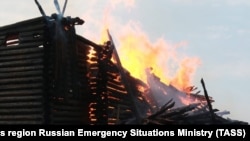VLADIMIR, Russia -- The unique, UNESCO-protected 12th-century Golden Gate is a gem of this ancient city some 200 kilometers east of Moscow.
Currently, it is owned by the Culture Ministry and houses an exhibition about the seizure of the city by Mongols in 1238. It is one of the key stops along the legendary Golden Ring tourist route of quintessential medieval cities including Yaroslavl, Suzdal, Kostroma, Rostov, among others.
But if the Russian Orthodox Church gets its way, the Golden Gate could soon become church property. The church has submitted a claim to the fortification, one of hundreds of similar claims it has filed with the government since passage of a 2010 law on the restitution of church property.
Officials and many locals in Vladimir are not happy at the prospect of turning over a talisman of the city to the church.
"The Golden Gate has long been the symbol of our city -- and not a religious symbol," said Aleksandr Karpilovich, spokesman for the mayor's office. About 1,000 people have signed an online petition urging that the church's request be denied.
Local activist Ilya Kosygin, who started the petition and whose grandmother's family actually was assigned housing inside the Golden Gate in the 1920s, agrees.
"It is the foundation of our local identity," he said. "This is the Golden Gate – Vladimir is an ancient city, a former capital. This is an important feeling to have."
The church's claim to the edifice is based on the presence of a small church above the gate, inside the fortification.
"But the Golden Gate was never a working church," said Alica Aksyonova, former founding director of the Vladimiro-Suzdal museum complex. "In all eight centuries of its existence, almost nine now, they only held services there for [only] 40 years."
She added that one must ascend 64 medieval steps to reach the church, meaning it is essentially useless for services intended for the Russian Orthodox Church's largely elderly constituency. In addition, she added, the museum complex has never stood in the way of the church conducting services in any of the buildings under its control. But now things have changed.
"The main thing [for the church] is to be able to report that one more monument of the 12th century belongs to the church," Aksyonova told RFE/RL. "They are going after everything -- every day, insatiably."
The 8-year-old restitution law was intended to enable the church to regain control of religious buildings that were forcibly nationalized by the atheist Soviet government. Many of those buildings were destroyed, while others were abandoned or used as storage. Beginning in the 1960s, however, many of the most prominent monuments were restored by the government and turned into museums.
Under the 2010 law, the decision on restitution is up to the government's property agency, Rosimushchestvo, which is one of the most opaque agencies in the Russian government. The Culture Ministry, which owns many of the properties in question, is only able to submit a counterstatement with its objections. The law stipulates that if a property is handed over to the church, the state must give an "equivalent" property to the previous owner.
In the case of the Golden Gate, said museum director Igor Konyshev, that is simply nonsense. He added that past experience shows that restitution to the church means sharply reduced public access to the country's cultural heritage.
"In the mid-1990s, about 15 local churches were handed over to the church," Konyshev said. "Among them was the UNESCO monument the Prokrov na Nerli Church. These days, the Prokrov na Nerli Church has basically been eliminated from the tourist agenda.... Yes, you can see it on the covers of [history and culture] textbooks, but just try to get inside it!"
Since 2012, the church has applied to have 26 monuments in Vladimir Oblast restituted, including the Georgiyevsky Cathedral in Gus-Khrustalny and the Spaso-Yefimiyevsky Monastery in Suzdal. Most of the church's applications are eventually granted because, under the law, they can be refused only if it can be demonstrated the building never served a religious function.
But it is far from a local phenomenon. There is no general database, but local media reports from the last few weeks show the church seeking three buildings in downtown Yekaterinburg, a residential building in Moscow, a riverfront plot of land in Cheboksary, and the St. Nicholas Cathedral in St. Petersburg.
According to the newspaper Delovoi Peterburg, authorities in St. Petersburg alone have transferred 101 monuments to religious organizations since the restitution law was passed -- most of them to the Russian Orthodox Church.
Last month in Yaroslavl, church lawyers gathered for a seminar on how to make applications under the 2010 law.
On August 10, the entire country was rocked when the iconic, 18th-century wooden Uspensky Church near the far northern town of Kondopoga went up in flames and was completely destroyed.
Although authorities suspect arson, some experts are blaming the Russian Orthodox Church, which gained ownership of the masterpiece from the Culture Ministry in May 2017.
"The church was given a gift of enormous value," said Vyacheslav Orfinsky, a professor of architecture and director of the Folk Architecture Research Institute. "The church definitely bears responsibility. We all thought those people would be doubly interested in protecting it -- for religious reasons and because of their moral code. But this incident shows their complete lack of care. Gaining control of such a monument, they should have done everything to protect it. The church has to answer for what happened."
"This was not only a religious monument," he added. "It was a cultural monument, a monument of our common culture. I think that in the best case, what happened shows irresponsibility and bungling by the church.... Such national treasures must be under the protection of the Culture Ministry."




